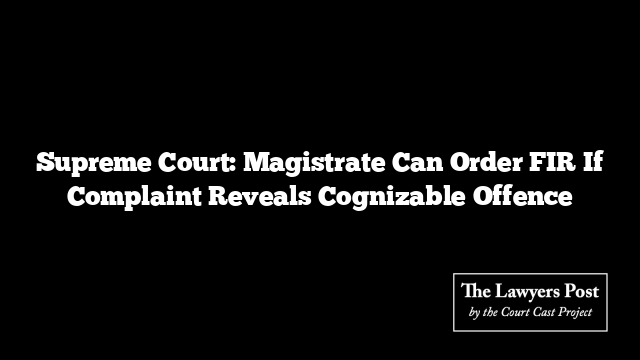The Supreme Court has ruled that when a complaint clearly outlines the commission of a cognizable offence, a magistrate has every right to direct the police to register an FIR under Section 156(3) of the Criminal Procedure Code (now Section 175(3) of the Bharatiya Nagarik Suraksha Sanhita).
A bench comprising Justice Pankaj Mithal and Justice Ahsanuddin Amanullah set aside the Karnataka High Court’s decision that had quashed an FIR registered on a magistrate’s direction. The Court emphasized that, at the pre-cognizance stage, the magistrate’s role is limited to examining whether the complaint discloses a cognizable offence—not to determine the truth or credibility of the allegations.
The ruling drew support from the 2013 Supreme Court decision in Madhao v. State of Maharashtra, which held that a magistrate can justifiably send a complaint to the police for investigation if doing so aids justice and avoids unnecessary judicial inquiry into matters that fall within the police’s investigative domain.
The case before the Court involved a forged rent agreement allegedly used to mislead the High Court. After the local police failed to act on the complaint, the complainant approached the Judicial Magistrate First Class, who, upon verifying that the e-stamp paper was indeed fake, directed the police to register an FIR under Section 156(3) CrPC.
Following this direction, an FIR was lodged under Sections 468 and 471 (forgery), 420 (cheating), and 120B (criminal conspiracy) of the IPC. However, the Karnataka High Court quashed the FIR, stating that the magistrate’s order suffered from procedural flaws and that no prima facie case existed.
The Supreme Court disagreed, observing that the High Court had erred by intervening too early in the investigation process. Justice Amanullah, writing the judgment, noted that the magistrate had sufficient material to justify police investigation and that the complaint clearly revealed the commission of a cognizable offence.
Declaring the magistrate’s order “unimpeachable,” the Court restored the FIR and directed the police to complete the investigation expeditiously. It further allowed the parties involved to present any material supporting their defence during the investigation or before the concerned court as the proceedings progress.





